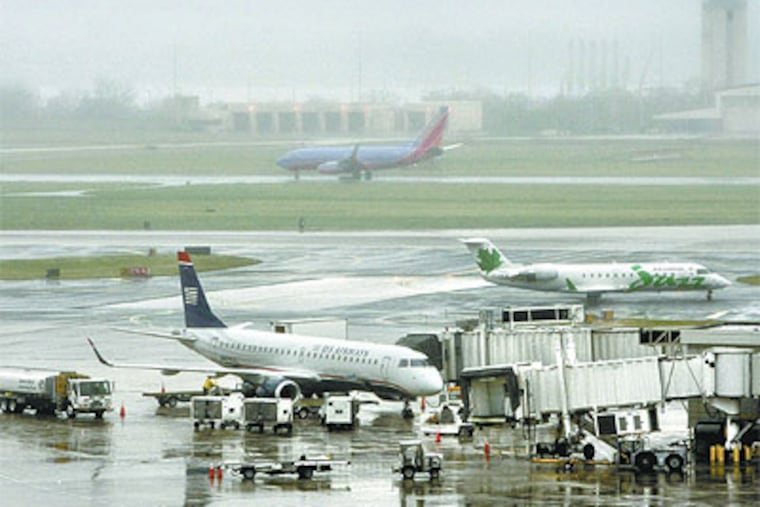Airport planning $5.2 billion expansion
A $5.2 billion expansion plan for Philadelphia International Airport over the next 12 to 15 years is designed to accommodate dramatic growth and help alleviate delays.

Originally published May 7, 2010: A $5.2 billion expansion plan for Philadelphia International Airport over the next 12 to 15 years is designed to accommodate dramatic growth and help alleviate delays.
The proposal released by the Federal Aviation Administration, sifted from 29 options considered in 2000, would lengthen two of the airport's four runways and build a fifth runway along the Delaware, where UPS now operates.
UPS would move to the airport's west end on 200 acres in Tinicum Township that the airport would acquire.
The FAA plans to issue a final environmental impact statement by late summer, and a "record of decision" on the project by year's end.
The FAA conducted environmental studies and held public meetings from 2003 to 2008. The agency said this plan would not disrupt I-95 traffic, costs less than the alternatives, offers more flexibility during construction, and has less environmental impact.
"Expansion of the airport is vitally critical to economic and business development in this city and region," said airport chief executive officer Mark Gale. "If we don't do these improvements, we will be locking ourselves into continued delay problems.
"We will not be able to grow and gain the capacity that we need to handle the traffic that we believe is coming our way."
Philadelphia was the sixth-most-delayed U.S. airport in 2007 because of congested East Cost airspace, the FAA said.
By 2020, 20 million passengers a year are expected to board flights in Philadelphia, up 33 percent from 15 million "enplanements" last year, Gale said. More than 30 million travelers total, including those arriving, passed through Philadelphia airport in 2009, and the number could grow to 40 million in a decade.
Studies said the airport's annual economic impact was $14.4 billion in 2006.
The construction would be paid for by Philadelphia revenue bonds, passenger-facility charges, and federal FAA grants - not taxpayers, Gale said. Debt service on the bonds is primarily paid for by rates and charges that airlines pay.
The proposal, dubbed Alternative A, would:
Lengthen Runway 8-26 east by 2,000 feet for a total length of 7,000 feet.
Extend Runway 9R-27L east by 1,500 feet, and rename what will become a 12,000-foot runway to 9C-27C.
Build a new 9,103-foot runway, to be named 9R-27L, on the Delaware River. The west end of the runway would extend into the river 670 feet and be built on fill or piles.
Expand the terminal complex from 120 to 150 gates, and build a new commuter terminal east of Runway 17-35.
Erect a transit "automated people mover" with tracks and train cars to transport passengers from a new commuter terminal to existing terminals, and eventually to parking lots.
Enlarge parking garages A, C, and D, adding 3,500 spaces, and reconfigure the economy parking lot to add 100 spaces.
Construct a ground transportation center with 4,000 parking spaces for a consolidated rental-car facility, van services, shuttles, and SEPTA.
The expansion is a plan for the airport, and not airspace.
"There will not be changes in flight patterns over the state of Delaware," said FAA spokesman Jim Peters. "We will use the existing entrances and exits that we now have in airspace to get the aircraft into and out of the airport.
"If this new runway were to be built, you will have aircraft flying along the river where they may not be flying now," but planes will fly existing routes over New Jersey and Pennsylvania, Peters said.
The plan calls for relocating or closing several public roads and relocating railway facilities.
The existing SEPTA airport rail line would connect with the new transit system shuttling passengers between terminals. Part of Tinicum Island Road would be relocated, and a portion of Hog Island Road closed. Island Avenue would be relocated between Penrose Avenue and Enterprise Avenue. The Cargo Access Road, Recirculation Road, and Airport Exit Road all would be relocated.
Several off-site facilities would be acquired and some relocated:
The Sunoco Logistics Hog Island Wharf complex would be removed, and the Sunoco Logistics Fort Mifflin complex upgraded to consolidate fuel off-loading and storage requirements. The Fort Mifflin Complex dock would be extended 1,000 feet west.
The airport would acquire and demolish buildings at the International Plaza, and acquire 106.5 acres of private land east of the airport from 13 owners and demolish the buildings. Two public streets, Escort Street and Executive Avenue, would be closed.
About 118 acres in the U.S. Army Corps of Engineers Fort Mifflin dredge disposal site would be used to extend Runway 8-26. About 177 acres north of I-95 would be acquired or transferred from the City Water Department to the Army Corps to replace lost Fort Mifflin dredge land.
The National Guard Pier and part of the National Guard facilities in the Fort Mifflin Army Corps area would be acquired and demolished. Under the proposal, three off-site privately owned parking facilities would be eliminated.
The airport is "still in discussions" with UPS about relocating, said Gale, who called the FAA sketch a "conceptual draft." The airport may have to take "mitigation measures" if a final FAA review finds that construction will affect nearby wetlands. "But I think we could be into on-airport construction by next summer," Gale said.